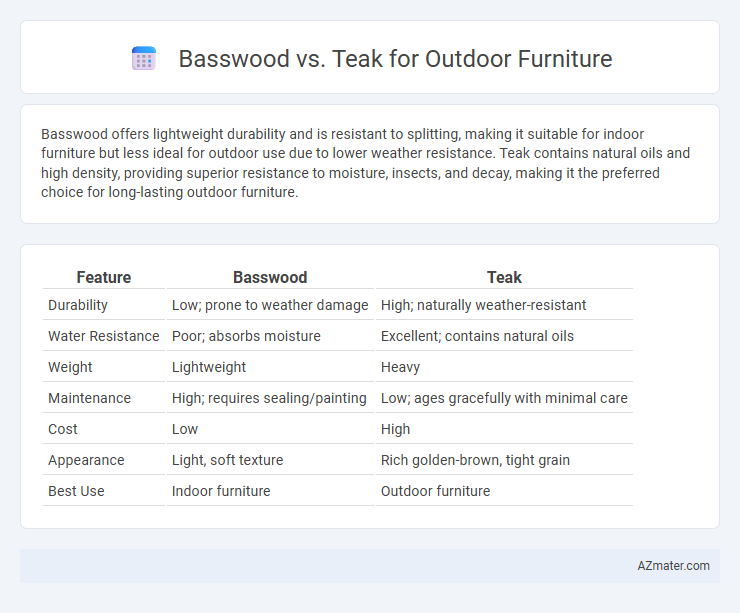Basswood offers lightweight durability and is resistant to splitting, making it suitable for indoor furniture but less ideal for outdoor use due to lower weather resistance. Teak contains natural oils and high density, providing superior resistance to moisture, insects, and decay, making it the preferred choice for long-lasting outdoor furniture.
Table of Comparison
| Feature | Basswood | Teak |
|---|---|---|
| Durability | Low; prone to weather damage | High; naturally weather-resistant |
| Water Resistance | Poor; absorbs moisture | Excellent; contains natural oils |
| Weight | Lightweight | Heavy |
| Maintenance | High; requires sealing/painting | Low; ages gracefully with minimal care |
| Cost | Low | High |
| Appearance | Light, soft texture | Rich golden-brown, tight grain |
| Best Use | Indoor furniture | Outdoor furniture |
Introduction: Basswood vs Teak for Outdoor Furniture
Basswood and teak differ significantly in durability and weather resistance, crucial factors for outdoor furniture. Teak's high natural oil content provides exceptional protection against moisture, insects, and decay, making it a top choice for outdoor use. Basswood, while lightweight and easy to work with, lacks the durability and weather resistance of teak, often requiring additional treatments to withstand outdoor conditions.
Material Overview: Basswood and Teak Explained
Basswood is a lightweight, soft hardwood known for its fine grain and ease of carving, making it less durable for prolonged outdoor exposure without proper treatment. Teak, a dense tropical hardwood rich in natural oils, offers exceptional resistance to moisture, insects, and rot, making it ideal for outdoor furniture. The inherent weather-resistant properties of teak give it a significant advantage over basswood for durability and longevity in outdoor applications.
Durability and Weather Resistance Comparison
Basswood offers moderate durability and low weather resistance, making it less suitable for prolonged outdoor exposure without protective treatments. In contrast, teak is renowned for exceptional durability and natural weather resistance due to its high oil content and dense grain, which effectively repel moisture and insects. Teak's resistance to rot and warping surpasses basswood, making it the preferred choice for long-lasting outdoor furniture.
Maintenance Requirements for Basswood and Teak
Basswood, known for its softness and light color, requires regular sealing and protection from moisture to prevent warping and decay when used in outdoor furniture. Teak contains natural oils that provide excellent resistance to water, insects, and rot, significantly reducing the need for frequent maintenance compared to Basswood. Properly maintained Teak can last for decades with minimal upkeep, whereas Basswood demands more consistent care to preserve its durability and appearance in outdoor environments.
Aesthetic Differences: Color, Grain, and Aging
Basswood features a pale, creamy color with a fine, even grain that maintains its light tone over time, providing a subtle, minimalist aesthetic ideal for modern outdoor furniture. Teak displays a rich golden-brown color with a pronounced, straight grain pattern that deepens to a warm amber patina as it ages, adding a luxurious and classic appeal. The natural oils in teak enhance its color retention and weather resistance, while basswood may require regular finishing to preserve its appearance in outdoor settings.
Eco-Friendliness and Sustainability of Each Wood
Basswood is a lightweight, fast-growing hardwood commonly sourced from sustainably managed forests, making it a more eco-friendly choice for outdoor furniture with lower environmental impact. Teak, while highly durable and naturally resistant to weather, often involves concerns over deforestation and illegal logging unless certified by organizations like FSC (Forest Stewardship Council). Choosing FSC-certified teak ensures sustainable harvesting practices, whereas basswood's rapid renewability offers significant advantages in reducing carbon footprint and preserving biodiversity in outdoor furniture production.
Price and Value: Cost Comparison
Basswood offers an affordable option for outdoor furniture, typically priced lower than teak due to its softer wood characteristics and faster growth rate. Teak commands a higher price because of its natural oil content, durability, and resistance to weathering, which extends furniture lifespan and reduces maintenance costs. While teak's initial investment is greater, its long-term value and resilience often justify the expense compared to the budget-friendly but less durable basswood.
Suitability for Various Outdoor Environments
Basswood offers moderate resistance to moisture and is best suited for covered outdoor areas with limited direct exposure to rain and sun. Teak stands out for its exceptional durability and natural oils that provide superior resistance to water, pests, and UV rays, making it ideal for diverse outdoor environments including coastal and humid regions. Choosing teak ensures longevity and minimal maintenance in harsh climates, whereas basswood requires protective treatment or sheltered placement to maintain its condition.
Pros and Cons of Basswood for Outdoor Furniture
Basswood offers a lightweight and fine-grained texture that makes it easy to work with for outdoor furniture, but it lacks the natural oils and dense grain of teak, leading to lower resistance against moisture and insect damage. Its affordability and smooth finish provide budget-friendly options, though it requires regular sealing or treatment to withstand weathering and prevent warping or cracking. The pale color of basswood can fade or stain over time when exposed to sunlight, unlike the rich, oily durability of teak that naturally resists decay and maintains a robust outdoor presence.
Pros and Cons of Teak for Outdoor Furniture
Teak is highly valued for outdoor furniture due to its exceptional durability, natural resistance to water, pests, and decay, and rich golden-brown color that deepens over time. Its dense grain and high natural oil content make it low-maintenance and able to withstand harsh weather conditions without warping or cracking. However, teak's premium cost and slower natural drying process can be drawbacks compared to other woods like basswood, which is softer and less weather-resistant.

Infographic: Basswood vs Teak for Outdoor furniture
 azmater.com
azmater.com